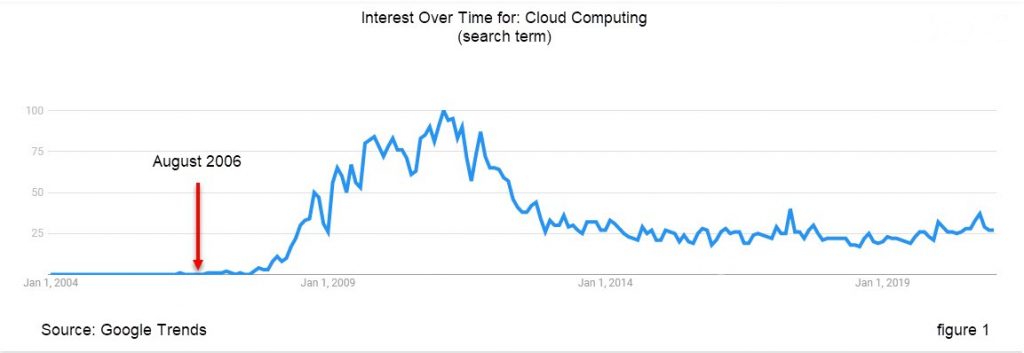Cloud Computing Defined?
Article Categories
Cloud computing has evolved from early definitions like anything hooked to the back of a server cabinet to a widely accessible storage solution to discrete layers of computing services. Today a Google search for cloud computing returns over 450 million search results. This article provides a brief history of the term and discusses current usage and the future concepts of cloud computing.
It is interesting to note how technical terms can change in scope over time. This is especially true when the technical term reaches buzzword status. If you ask five random people what cloud computing means, you will likely get five different answers.
Regardless of the product being sold, marketing is a difficult job. I’m not surprised that marketers take the opportunity to link their product features and benefits to concepts the public feels good about. Over the years, marketers have found ways to claim pieces and parts of cloud computing for the widget or process they sell. According to Google Trends displayed in figure 1, the cloud computing term peaked in March 2011 but has maintained a steady interest since 2014.

Unlike many buzzwords, cloud computing has been around for years and still seems to have a lot of life left.
If you need to provide for significant new IT hardware growth or currently have shared or under performing, resource starved hardware, you may not see a savings after moving to cloud computing.
Cloud Computing Somewhat Defined
Where 2006 is the commonly accepted date the term was first used, Technology Review tracked the term usage to a decade earlier. In late 1996, a group of Compaq Computer executives, while discussing the future of Internet business, used the term “cloud computing.”
The more recent date of August 9, 2006 has been-pegged as the first recorded use of the term. Google CEO Eric Schmidt used it during a Search Engine Strategies Conference hosted by Danny Sullivan. Figure 1 agrees and the term began to see wider use during the Fall of 2006.
There are plenty of definitions for cloud computing to be found. Like the parable of a group of blind men describing an elephant where each man only touches one part of the animal. Those new to cloud computing can assume different features and benefits from cloud platforms depending on what parts of the platform you touch. Adding to the definition difficulty, Amazon, Microsoft, IBM and Google have computing offerings that are different from much of today’s mainstream cloud products.
These tech giants, and a few others have reduced the dependency on single servers for providing computing power. Instead of being hooked to a hardware node in one data center, they show computing power can be provided by a distributed network of resources making a hardware failure less noticeable.
Over time, product copywriters have found more ways to tie their products to “the cloud” causing the definition to become a catch all term. In today’s accepted usage, cloud computing has come to simply mean connected to the internet.
Some Desirable Characteristics of Cloud Computing
A lack of dependency on dedicated hardware is a cloud trait. The internet freed us from the desktop workstation and office networks by providing powerful servers in diverse locations. Two cloud prominent characteristics benefiting from distributed hardware are scalability and elasticity.
Scalability
Scalability relates to the ability to respond to changes in workload by using available resources to meet resource demands without impacting performance. Scaling up is limited by the amount of extra capacity available in the system and is usually preplanned to handle expected peaks inside the existing infrastructure. Scaling out is where the hosting environment can provide multiple systems quickly enough to meet unplanned peak demands.
Elasticity
Elasticity controls the computing environment in more structured and automatic ways to meet changing resource needs. Most hosting schemes have a built-in ability to handle additional loads. But we, as computing consumers, tend to take the availability of computing power for granted and focus on lower cost instead. This, more for less pressure, forces hosting providers to over sell their servers in order to remain competitive. Meaning there often isn’t anything left over for peak loads in many hosting environments.
Cost of Cloud Computing
Your current hosting design is a primary driver for any cost saving caused by a move to cloud computing. If you have historically purchased your own hardware and rent cabinet space in a data center, you may very likely see a saving after moving to cloud services. If you rent a server and have it provisioned for 100% peak usage, you might also save money with a cloud solution.
Measured Services & Pay as you go
Where cloud computing may not guarantee a reduction in computing cost, the billing methods will definitely look different. Expect the various pieces like the CPU, database(s), RAM, bandwidth, IPs, backup, disk space and longer term storage to be offered al la carte and billed by the hour.
Going back to cost, if you are moving from a dedicated server provisioned for max resources, there can be saving if these resources are not needed one hundred percent of the time. Say, for example, your marketing department sends 20,000 emails at the same time to prospects once a month. You can plan to scale out to additional CPUs during the once a month peak but fall back to lower resource usage for the rest of the month. The computing power could be reduced for the whole month and the additional CPUs would only be online while large numbers of clients where visiting eCommerce links from the marketing newsletter.
Cloud Computing Characteristics
To recap, cloud computing is rapidly evolving to meet the ever growing needs of increased computing power, more speed, and greater storage. Infrastructure-as-a-Service (Iaas), provides compute power, network, and storage resources to users on-demand, over the internet, on a pay-as-you-go basis. The service allows end users to scale and shrink resources to match workloads, reducing large, front-loaded capital expenses for equipment purchases that can be rented to meet demands.
IBM, a leader in IaaS, lists the following advantages cloud computing provides.:
-
Cost of entry: Unlike traditional IT, IaaS does not require any upfront, capital expenditures, and end users are only billed for what they use.
- Speed: With IaaS, users can provision small or vast amounts of resources in a matter of minutes, testing new ideas quickly or scaling proven ones even quicker.
- Availability: Through things like multizone regions, the availability and resiliency of cloud applications can exceed traditional approaches.
- Scale: With seemingly limitless capacity and the ability to scale resources either automatically or with some supervision, it’s simple to go from one instance of an application or workload to many.
- Latency and performance: Given the broad geographic footprint of most IaaS providers, it’s easy to put apps and services closer to users, reducing latency and improving performance.
Looking Ahead
Looking ahead, the future of cloud computing is poised for continued growth and innovation. As technology advances and demands increase, cloud computing will play an increasingly vital role in empowering organizations to adapt, innovate, and thrive. The advent of technologies like artificial intelligence, machine learning, and the Internet of Things will further expand the possibilities of cloud computing, enabling businesses to leverage data-driven insights, automate processes, and create more personalized experiences for their customers.
Furthermore, cloud computing providers are constantly enhancing their offerings to address emerging challenges and meet evolving customer needs. With ongoing advancements in security, privacy, and compliance, businesses can confidently migrate their critical systems and sensitive data to the cloud. The availability of advanced data analytics and integration tools within cloud platforms empowers businesses to gain valuable insights, improve decision-making, and unlock new opportunities for growth.
Wrap Up
In conclusion, cloud computing has transformed the IT landscape, providing organizations with the agility, scalability, and cost-efficiency required to thrive in the digital era. Its independence from dedicated hardware, scalability, elasticity, measured services, and pay-as-you-go model have revolutionized resource provisioning and management. As technology continues to evolve, cloud computing will continue to evolve as well, empowering businesses to adapt to changing demands, drive innovation, and unlock new possibilities for success in an increasingly digital and interconnected world.
NEW ARTICLES
Celebrating Two Decades of WordPress
WordPress has proven to be an unstoppable force in the ever-evolving digital landscape, where adaptability and customization are keys. As we look at the first twenty years [...]
DISCLAIMERS:
WPChronicle.com uses affiliate links and pay-per-action advertising. If you click these links or use them to buy something we may earn a commission.
WPChronicle.com may contain copyrighted material. This use may not have been specifically authorized by the copyright owner. The material contained in this website is distributed for informational and educational purposes. Small portions of the original work may have been used but those portions could not easily be used to duplicate the original work. This usage constitutes ‘fair use’ of any such copyrighted material (referenced and provided for in section 107 of the US Copyright Law).
All trademarks displayed here are the property of their owners and are neither an endorsement nor a recommendation for or from those organizations. The use of trademarks or links to the websites of third-party organizations is not intended to imply those organizations endorse or have any affiliation with WPChronicle.com.

